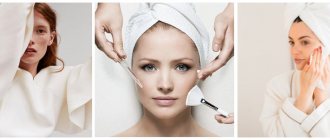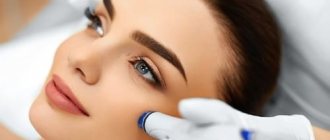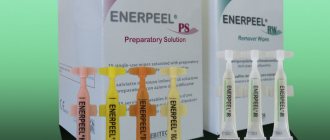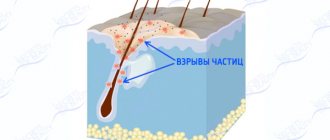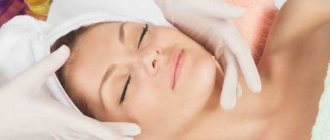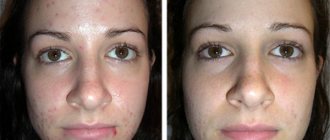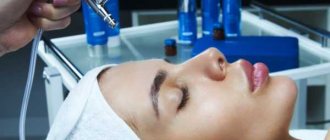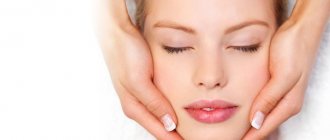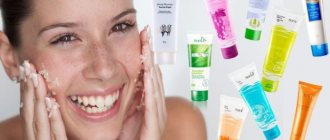From this article you will learn:
- What are the advantages of salicylic peeling compared to other cosmetic procedures?
- What are the indications and contraindications for salicylic peeling?
- How does the salicylic peeling procedure work?
- How to care for your skin during the rehabilitation period
Salicylic peeling is considered a universal cosmetic procedure that is used for almost any skin problem. It allows you to get rid of acne, porosity, oiliness, and age spots. In addition, peeling is great for both young girls and adult ladies with sensitive, dry and aging skin.
Benefits of salicylic peeling and how it works
Salicylic peeling is a chemical procedure that involves removing dead skin layers by applying salicylic acid. To make the manipulation more effective, lactic or fruit acid can be added, and this method can be used both on the face and in the décolleté, back, arms, etc. As for age, there are no restrictions here either.
It is worth noting that salicylic peeling is a fairly simple procedure to carry out and is performed under the supervision of a specialist. The main component, that is, salicylic acid, is also called phenolic and hydroxybenzoic acid. The source of its production is willow bark, anise and ylang-ylang. Salicylic peeling is one of the most effective remedies in the fight against acne. The acid, which is used in many anti-acne products, has the following effects:
- Makes the skin more youthful in case of hormonal aging and photoaging.
- Eliminates solar hyperkeratosis, as well as spots, both senile and pigmented.
- Has a healing effect on acne.
- Kills bacteria that cause rashes.
- Fights oily skin, drying it, and also regulating the functioning of the sebaceous glands.
If you compare facial peeling with salicylic acid with the use of lotions and creams, it affects problem areas more deeply.
The procedure has six advantages, which are as follows:
- Fight acne. The skin dries, which not only eliminates acne, but also leaves no traces of it.
- Cleansing the sebaceous glands from blockage and restoring their function.
- Whitening effect. The procedure allows you to lighten freckles, remove age spots and blackheads.
- Salicylic peeling can be done for people with any skin: dry, oily, dark and sensitive.
- Thanks to the targeted effect only on problem areas of the dermis, healthy cells are not damaged.
- Rejuvenating effect as a result of intense blood flow to the face. In addition, skin renewal and tightening occur during the procedure.
As for the disadvantages, there are few of them, and they almost always arise during exfoliation:
- burning sensation when applying the product;
- After the procedure, it is forbidden to visit the bathhouse or play sports;
- Until the skin heals, you should not apply makeup.
Acid has a comprehensive effect on the dermis, making it more youthful, fresh and renewed.
Read the material on the topic: Chemical peeling of the face: your skin will breathe a new breath!
All about retinoic acid
Retinoic acid is a substance (acetic acid) with properties similar to retinol (vitamin A). But the first substance is stable when used externally. It helps exfoliate the skin. Retinoic acid normalizes metabolism and protects cells from free radicals. The substance has a number of positive features.
- Acid significantly improves the properties of the dermis. As a result, the local immunity of the skin improves and its need to protect itself from harmful bacteria increases. The process of development of purulent wounds is suspended.
- Retinoic acid helps restore tissue in various skin diseases. Under its influence, acne heals faster and the development of skin pigmentation decreases. It also helps heal skin after burns.
- The acid gives a lightening effect by blocking the activity of the enzyme tyrosinase, which is responsible for the synthesis of melanin.
Retinoic acid must be used with caution, as it can give the unborn child some pathologies. Therefore, a woman can perform such facial peeling, but without being pregnant.
Retinoic acid can be used for perioral dermatitis, acne, seborrheic dermatitis, wrinkles and sagging skin. This remedy is intended for the treatment of acne with cystic acne. The acid does not affect the scars themselves, but it prevents the appearance of skin defects.
Types of salicylic peeling
Today there are two types of procedure:
1. Superficial peeling using 10–15%, sometimes 20% salicylic acid. It has a refreshing and rejuvenating effect on young skin with acne problems. Oiliness is removed, pores become narrower, and the number of blackheads and pimples is either significantly reduced or they disappear completely. The skin is smoothed, the complexion acquires a healthy and even tone. Superficial salicylic peeling is allowed for patients over 16 years of age. Its duration is about 15 minutes.
The main indications for the procedure include:
- clogged pores;
- oily skin;
- various rashes;
- small wrinkles.
2. Medium peeling performed with 25% or 30% salicylic acid. This procedure is excellent for combating deep wrinkles and aging skin. As for the age category, persons over 35 years old are allowed to undergo medium peeling. The procedure itself lasts no more than 10 minutes.
Indications for use in this case are as follows:
- deep wrinkles;
- post-acne;
- turgor dehydration.
For more convenient use, the products are available in two versions:
- A paste that is more suitable for hands, elbows, knees and other parts of the body with rough tissue.
- Liquid solution for salicylic facial peeling.
Read material on the topic: Peeling roll for the face: features of the procedure, indications and contraindications
Ferulic acid: peeling
Ferulic acid is extracted from the ferula plant, which has a wide range of actions: it has antiviral, anti-inflammatory, anti-allergenic and antibacterial effects. It is often included in many biological and cosmetic products.
Ferulic acid has the following active properties:
- improves the production of collagen and elastin, which helps restore skin firmness and elasticity, as well as get rid of fine wrinkles;
- has a lightening effect, which helps eliminate pigmentation;
- actively fights against photoaging;
- fights acne, blackheads and acne marks;
- stops the growth of bacteria;
- promotes rapid healing of wounds;
- protects skin from exposure to sunlight;
- helps restore dull and aging skin;
- has tonic properties;
- restores skin turgor.
In addition to the main component, ferul peeling also includes other types of fruit acids, which not only cleanse the skin of dead cells, but also nourish the cells with nutrients, vitamins and minerals.
Ferulic acid peeling, in addition to beneficial acids, contains cleansing substances suitable for each layer of the skin. This peeling helps slow down the aging process, since after the procedure the metabolic process in cells accelerates, which promotes the production of collagen and elastin.
Indications and contraindications for the use of salicylic peeling
It is worth noting that indications for peeling can appear at any age. For example, young girls often use salicylic acid to get rid of acne and pimples. Older women resort to this manipulation for rejuvenation, wrinkle removal and other reasons. You can notice the difference in the skin from salicylic peeling before and after the procedure with the naked eye by looking at the photo located just above.
As for general problems, this manipulation is performed in the following cases:
- for oily skin with enlarged pores, as well as a tendency to form plugs in the sebaceous glands, pimples and blemishes;
- blackheads (comedones);
- in the first and second stages of acne (in more advanced cases, that is, in the third and fourth stages, peeling is used only as prescribed by a dermatologist after treatment of the cause of their appearance with medication);
- scars, post-acne and shallow wrinkles;
- hyperpigmentation, including age-related;
- hyperkeratosis (including solar);
- signs of photoaging;
- age-related skin problems, such as blemishes, acne, enlarged pores, comedones and sebaceous gland plugs;
- seborrhea.
Chemical peeling with salicylic acid is performed on any part of the body. This includes the neck, elbows, décolleté, knees, and feet.
However, even though the procedure is quite gentle, it has some contraindications:
- acute form of herpes;
- pregnancy and lactation;
- rosacea;
- diabetes;
- intolerance to a particular drug included in the composition;
- microtraumas, abrasions and wounds present on the body.
Many people are interested in the question of whether it is possible to do salicylic peeling in the summer. Cosmetologists do not put any prohibition regarding this, but for some time after the procedure for three to four days you should not be in direct sunlight or visit a solarium.
Recommended articles on the topic:
- Depigmentation peeling: everything you wanted to know about it
- How to properly care for your skin
- How to remove wrinkles on the face: the most effective methods
Indications
Ferulic peeling can be used for the following skin conditions:
- the presence of pimples and acne;
- presence of post-acne marks;
- strong pigmentation;
- increased oily or dry skin;
- enlarged pores;
- processes of early skin aging;
- skin dehydration;
- dull skin;
- black dots;
- tendency to inflammatory rashes;
- skin changes caused by bio- and photoaging;
- small wrinkles;
- dark circles under the eyes, and is also prescribed as a prophylaxis against them.
Ferulic peeling is superficial, but unlike other peelings with fruit acids, the procedure can be carried out in the spring and summer without fear of the appearance of new pigmentation.
Chemical peeling with ferulic acid is recommended every year. On average, the course is about 7 days with breaks between each week. One of the main advantages of such peeling is that it does not cause peeling, swelling, burning and other unpleasant sensations.
How is the salicylic peeling procedure performed in a beauty salon?
Before performing salicylic peeling, the specialist conducts a conversation with the client in order to identify possible contraindications. This is necessary to avoid possible complications and side effects from the procedure.
After this, a diagnosis is performed to determine the most problematic areas of the skin that deserve special attention. Then proceed directly to salicylic peeling.
The procedure itself consists of the following steps:
- First, the master cleanses the surface of the skin from cosmetics and various types of impurities.
- Next, the dermis is treated with a softening solution, which disinfects and degreases it. This stage is very important, since the result of salicylic peeling will depend on how well it is carried out. Only on clean skin is it possible to distribute the components evenly.
- At the third stage, the surface is coated with salicylic acid of a certain concentration. The process of applying the product depends on this parameter. The higher the percentage, the later the most sensitive areas should be treated. After application, the acid is left for some time. The duration in this case depends on factors such as the concentration of the product, the thickness of the epidermis, the condition of the skin and other related problems.
- After a certain time, the acid is removed with water or another liquid intended for cleansing the skin.
- At the last stage, the doctor wears a mask with a calming effect for 15–20 minutes, and then an aloe cream for better tissue regeneration and protection from aggressive environmental factors.
If an unpleasant tingling or burning sensation appears after a salicylic peel, you need to tell a specialist who will direct a stream of cold air onto your face. This will create a crust (“frosting”) on the surface of the dermis, which in appearance resembles frost.
Another equally pressing issue is the required number of peeling procedures to achieve a good result:
- For preventive purposes in the neck, face and décolleté, the course will be 10 sessions with a break of 10 days.
- If treatment of pimples, acne and comedones is required, 8 procedures will be required every 7-10 days.
- To eliminate hyperpigmentation, you need to do 8 manipulations every 10–14 days.
- Hyperkeratosis will require two treatments every other week, followed by another 6-8 sessions 10 days apart.
It is worth remembering that it is not allowed to perform sessions earlier than the specified period, but later it is possible, but only according to individual indications.
In addition, the effectiveness of the procedure depends on the professionalism of the cosmetologist who performs it, the characteristics of the skin and its condition.
If the peeling protocol is strictly followed, the results should be as follows:
- already after the first session, the number of pimples at the treatment site becomes noticeably smaller;
- the synthesis of collagen and elastin is stimulated;
- fine wrinkles and small folds are removed;
- complexion becomes more natural;
- acne scars are reabsorbed and smoothed out;
- regeneration processes are activated.
Read material on the topic: Retinoic yellow peeling done by Hollywood stars
What are the features of the newest cleansing technique?
Spanish peelings have many positive properties. These include:
- immediate effectiveness of the product;
- safety;
- no allergies;
- pH in terms of acid content is fully consistent;
- there are no side effects.
During the procedure, the skin undergoes several stages. The session begins with cleansing the contaminated dermis. Then comes the stage of degreasing and peeling. Everything ends with washing and applying a soothing cream. The effect of the procedure will last for a long time.
Mediderma peeling can be applied in several ways:
- If you do not have ulcers or small cracks on your dermis, then a gentle method of applying the product is suitable for you. It is done with light touches using cotton swabs.
- There is also another, tougher way. It is carried out in a slow mode, thoroughly rubbing the product with cotton pads.
The effect of mediderma peels is simply amazing, but, unfortunately, it is not suitable for everyone. It is prohibited to carry out such cleansing sessions for people with allergic reactions and individual intolerance, the presence of fungi of various origins, minor damage to the dermis, sunburn, pregnancy and lactation.
How much does this miracle remedy cost? The price is determined by the type of product and the location of the salon. The average cost of regular surface cleaning reaches 3 thousand rubles. Medium - up to 5 thousand, and deep - from 6 thousand rubles. Each region has its own prices.
Post-procedure care
It is worth noting that the result of the salicylic peeling, which is visible in the photo above, also depends on how the patient himself cares for the skin after the procedure.
In order for the dermis to recover faster, you need to wait a certain period of time and follow simple rules. In addition, the duration of rehabilitation will depend on the type of peeling, that is, it was superficial or deep, as well as on the individual characteristics of the patient.
Typically, the recovery period after the procedure is about seven days, during which the following side effects may be observed:
- skin may feel tight and dry;
- in some cases, peeling and irritation are observed;
- redness and swelling;
- an allergic reaction is possible;
- At this time, an exacerbation of viral skin diseases may occur.
Since the acid does not penetrate into the deep layers of the epidermis during peeling, there are practically no side effects from the procedure. In addition, the possibility of skin injury is completely eliminated.
In some cases, the face turns red and begins to peel after salicylic peeling. However, under no circumstances should you remove the crusts formed in places where the skin is exposed to acid.
The process of drying of the dermis with the subsequent appearance of film and peeling depends on a large number of factors. For example, if the skin is thin, then desquamation will occur faster. The process is also accelerated if the concentration of the drug is high enough. However, it is worth noting that such reactions of the body may not occur at all, since each person’s skin reacts differently to the effects of a particular chemical.
You should be wary if the dermis is covered with watery or air bubbles, swelling, severe redness and pain appear. There is no point in dealing with such symptoms on your own; it is better to seek help from a cosmetologist. Very often this is either an allergy to the drug or an individual reaction of the client.
After the procedure, the following skin care should be provided:
- You need to stop washing your face for 1-2 days, depending on whether the peeling was superficial or medium.
- If during a light procedure there may be no redness, then with a deep type of exposure the intensity of complications depends on how sensitive the skin is.
- Once a parchment crust has formed, you cannot tear off dry pieces of dermis; they need to be moistened with Panthenol.
- At the time when peeling begins, you should not visit baths, saunas, beaches, swimming pools and other places with high temperature and humidity.
- Do not be in direct sunlight. No matter what weather you go outside in, you need to apply sunscreen. The fact is that the skin can react to the sun with the appearance of pigmentation.
- You can only wipe the dermis with a lotion that does not contain alcohol.
- Periodically apply nourishing or moisturizing cream.
Read material on the topic: Fruit peeling: in a beauty salon and at home
In addition to everything, it would be useful to use masks with minerals, vitamins, oils and herbal ingredients. This will allow the skin to recover faster.
Thanks to salicylic peeling, the dermis looks younger and smoother, the complexion is healthy, and the functioning of the sebaceous glands is improved.
Nowadays, you no longer have to spend a lot of time performing complex and unpleasant procedures at home. It is much easier to seek help from real professionals - the Veronika Herba beauty and health center, equipped with effective and modern equipment.
Why clients choose Veronika Herba Beauty and Health Center:
- This is a beauty center where you can take care of yourself at a reasonable cost, while your face and/or body will be treated not by an ordinary cosmetologist, but by one of the best dermatologists in Moscow. This is a completely different, higher level of service!
- You can receive qualified help at any time convenient for you. The beauty center is open from 9:00 to 21:00, seven days a week. The main thing is to agree with your doctor in advance on the date and time of your appointment.
Sign up for a consultation with a specialist by phone +7 (495) 085-15-13
, and you will see for yourself!
How to properly prepare the skin for the procedure?
There are several options to prepare your skin for peeling.
- You can use at least 21 days of Skinoren gel every time you go to wash your face.
- You can also use special cosmetics with fruit acids. Or carry out several cleansing procedures with fruit acids.
Without proper preparation for peeling, side effects may occur. You won't get the results you want. In addition to preparation, post-peeling rehabilitation will be required. Many cosmetologists may offer you a mesotherapy session to avoid drying out the dermis.
Causes of age spots
Skin pigmentation is disrupted if there is a process of accumulation of melanocytes, which are skin cells capable of protecting tissues from ultraviolet radiation. But if such radiation is prolonged, this can lead to melanocytes simply accumulating in a certain area of the skin. They, in turn, should be distributed evenly over the entire surface.
In addition to ultraviolet radiation, there are a number of reasons why age spots may occur:
- disruption of the liver, gall bladder, kidneys;
- hormonal changes that can occur both during and after pregnancy;
- the use of certain types of creams;
- diseases associated with the genital organs;
- taking contraceptives;
- insufficient amount of vitamins in the body, most often a lack of vitamin B3;
- frequent visits or exposure to the sun or solarium;
- early aging of the body, human skin.
Contraindications
- Individual intolerance (before the procedure, the cosmetologist is required to conduct an allergy test);
- Atopic, contact dermatitis, urticaria, ichthyosis;
- Herpetic eruptions on the face;
- Acute infectious diseases;
- Oncology;
- Treatment with roaccutane;
- Fever of any origin;
- Violation of the integrity of the skin;
- Furuncle, facial carbuncle;
- Hypervitaminosis A;
- Pregnancy, lactation or planning pregnancy in the next 6 months after the procedure. (Vitamin A and its derivatives have a powerful teratogenic effect. Consequently, they can cause congenital deformities and various defects in fetal development).
To avoid pigmentation, peeling is not recommended during periods of active sun.
What is a chemical peel?
An in-clinic chemical facial peel, or exfoliation, is a special procedure that works like a controlled burn to the skin to accelerate the correction of imperfections. In general, there are many effects from this technique:
- destruction and renewal of the epidermis;
- formation of young cells with a high percentage of moisturizing factor;
- smoothing the dermis, tightening it and increasing its uniformity.
Thanks to peeling in the clinic, the microrelief of the face becomes better, and the lifting effect is still noticeable. That is why the technique is relevant for girls and women of different ages - both those who suffer from acne and those who have encountered the first signs of aging.
It is important to discuss with your doctor the need for a peeling procedure, as well as find out its optimal type - then the effect will not be long in coming, and the risks will be minimized.
The specialist will be able to examine the skin and select the composition depending on the required concentration and the depth of its desired effect.
Ferul peeling Mediderma
Most often, cosmetology centers use Mediderma peelings, which have a high-quality composition aimed at eliminating skin defects and cleansing it. Mediderma ferul peeling contains useful components that help strengthen the walls of blood vessels, improve microcirculation and enhance the production of collagen and elastin. After a procedure using ferulic acid, the protective forces of the epidermis are strengthened, wrinkles are reduced, and the skin becomes tightened and fresh.
Mediderma ferul peeling has the following effect:
- promotes deep cleansing;
- brightens the skin;
- restores the epidermis;
- improves skin structure;
- reduces wrinkles;
- normalizes the production of sebaceous fat;
- helps get rid of pimples and blackheads, and also reduces the risk of their reappearance;
- moisturizes the skin, evens out the complexion.
Mediderma ferul peeling can be carried out in the summer, but it is still recommended to avoid exposure to the scorching rays of the sun for several days.
A week before the procedure, it is necessary to prepare the skin, namely, use fruit tonic and cream daily. It is better to exclude citrus fruits, sweets and carbonated drinks from your diet to avoid a negative reaction from the body.
Opinion of cosmetologists
Cosmetologists often recommend Mediderma yellow peelings to patients who lead an active social life - and are not ready to go through a long recovery period with excessive peeling of the skin.

